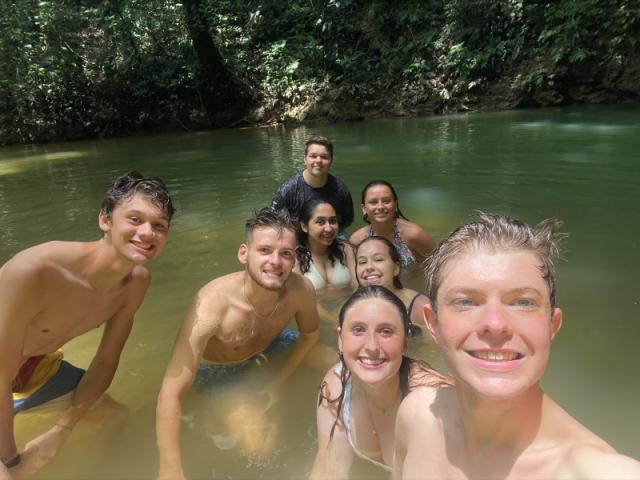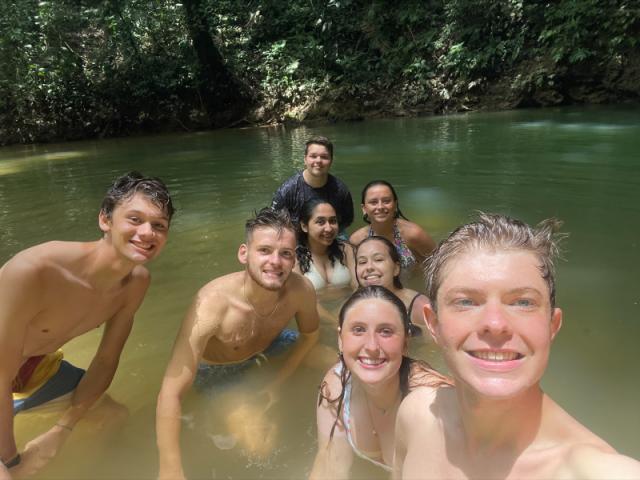By Richard LeComte
LEXINGTON, Ky. – Nothing like a baby jaguar caught on camera to get college students screaming with glee.
These college students – a group of eight – were deep in Central America’s nation of Belize learning how to assess wildlife populations using cameras. Led by Emily Croteau, lecturer in biology in the University of Kentucky’s College of Arts & Sciences, hit pay dirt on their first foray into this wild ecosphere this summer. Just getting the cameras in place was an adventure.
“It was actually really, really exciting, the first time that we went into the jungle to recover our camera traps,” said Quincy Ipsaro, a junior biology major from Cincinnati. “The first day we did probably a seven-to-10-mile hike into the jungle just to set up the cameras. It was so, so hot and the bugs were insane. It was probably some of the toughest conditions I've ever been through.”
They were able to mount the cameras, but they had very low expectations – Croteau said it’s difficult to capture photos of wildlife in such a short time. When they retrieved their data cards, however, what they found was amazing.
“We were gathered around this little camera that one of the other students had brought,” Ipsaro said. “And we inserted the card. One of the first things we saw was a tapir, which the locals call a mountain cow. It's kind of a cross between a horse and a rhinoceros. It's like the weirdest looking animal ever. We were all freaking out and screaming and so excited.”
But then the images got even better.
“A few slides later we see a Jaguar,” she said. “We were all jumping up and down freaking out because from what we heard from the locals, you don't typically get very much on these cameras. As we continued to click, a few slides later we see another little head and I'm like, ‘Hold on that's a baby! It's so much shorter than the last Jaguar, it must be a cub. And in the next slide there was a picture clear as day of a jaguar cub looking straight into the camera, and we all lost our minds.”
Croteau took eight students as part of the field study class. Belize, whose official language is English, encompasses a wide variety of ecosystems for such a small country. Croteau’s students were able to observe the tropical jungle climate in the first part of the education abroad program, and followed it up with two days of exploring the environment of the Caribbean seashore.
“I wanted to focus on conservation biology and giving the students an authentic field experience,” Croteau said. “Belize has a few different ecosystems. It has a really fascinating terrestrial ecosystem that ranges from lowland savannah areas and then into montane jungle. And then it has this marine environment as well along the coast. I wanted to give the students this opportunity to view all of that – be land lubbers for a while and then get into the ocean.”
Before the educational experience, Croteau gave the students two weeks of online instruction on what they’d be seeing and doing in Belize. The cameras form part of a wildlife survey techniques project that seeks to estimate the population of jaguars, pumas, ocelots, jaguarondis and margays. Biologists call the technique “camera trapping.”
“Setting the camera traps was really cool,” said Landon Howell, a junior biology major from Ashland, Kentucky. “It felt like we were actual researchers out in the wilderness.”
Croteau said the students were able to capture images of three of the five cat species as well as tapirs and agoutis.
“We had some decent results within a few days, which I never could have imagine would have happened,” she said. “We placed these cameras in savannah areas and jungle-type areas. Then we got the photos back at the end of the trip. And we did a lot of hiking, just to see the change in environments. There are really good trails in the Cockscomb basin, which is also the first jaguar preserve ever made.”
As part of the experience, the students got to rough it a bit: They said the accommodations inland were rustic. But at least the food was good.
“It was fairly barebones,” said Noah Cammack, a senior biology major from Owenton, Kentucky. “We didn't have any kind of fans or AC. Some of it was hot and humid. But we had our kitchen staff there. They were fantastic cooks, and they cooked local food. That was the best part of the accommodations.”
What’s more, after the inland experience, the students got to snorkel at Tobacco Caye, off the Belize coast. Here, the students got to fish.
“We saw a nurse shark, which was pretty interesting, and we hunted a few lionfish,”: Cammack said. “We saw a couple, actually. We brought one back for dissection. Lionfish are an invasive species in Belize, so they’re trying to cut down the population.”
Croteau and the students brought back the photos to use as data in the survey. And the students also brought back a deeper appreciation for conservation, for which Belize is known.
“The main thing that stood out for me is how focused all the people are on conservation,” Ipsaro said. “They really don't have as many resources as we do here in America. But people there are giving up land on their farms for animal sanctuaries, to make sure those animals have a proper habitat. People in Belize understand that the environment is a huge part of their economy.”





